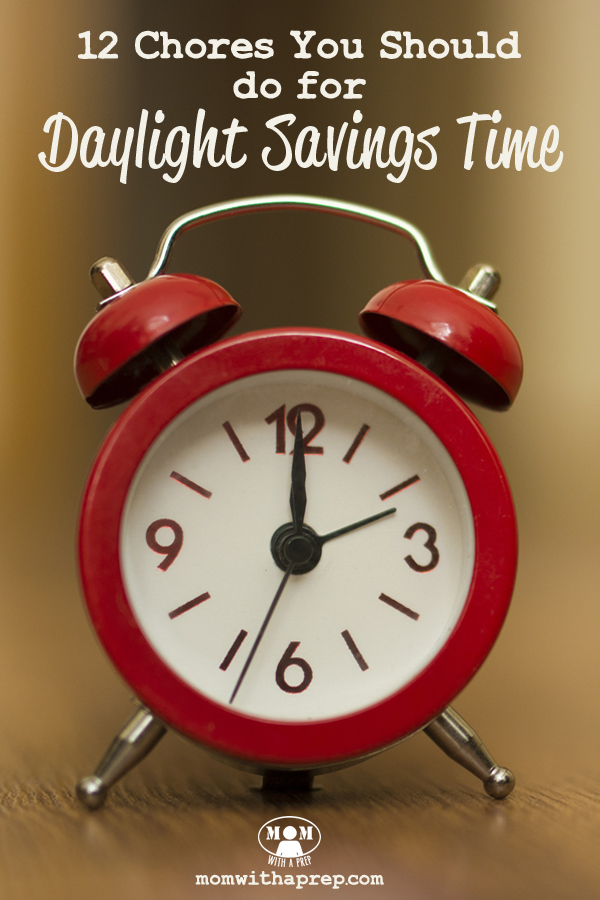
Daylight Savings Time always brings big groans at our house. We dislike the change to our routine, to our sleeping pattern, and the sun setting so late in the day for most of the spring/summer when we tend to not be sun-lovers in the first place.
It does have one benefit, though. I’ve also always found it hard to remember when to do certain chores when they don’t happen often. I used to mark my calendar at the beginning of each year of the yearly or bi-yearly events that needed to happen to help me remember. Now, I just use Daylight Savings Time to do these quick chores twice a year.
12 Chores for Daylight Savings Time
1. Change out the batteries in the smoke/carbon monoxide alarms.
Sure, those 9v batteries should last more than five months that you have been Daylight Savings ending and beginning, but use this good calendar reminder to change them out in your smoke detector/carbon monoxide alarms so that you don’t have to worry.
2. Update the car emergency kit from winter to spring or vice versa.
For the area that I live in, the new Daylight Savings Time schedule works perfectly for our change of seasons. We generally begin getting cooler in October and warm up in March, so it fits. But you might find doing it at a different time more beneficial for yourself. But at least check your car’s emergency kit to make sure to replenish things you may have used. (Get a checklist here)
3. Flip and vacuum your mattress.
We run our comforter through the cool cycle on our dryer to remove all lint, dust mites, dust and more. If I feel the need, I will have it dry cleaned since it is too big to go into our washer. We also rotate our mattress (hint…while most modern mattresses say you don’t need to rotate but once every six months, do so more often if you’re beginning to see signs of sagginess beforehand. And don’t buy a mattress that can’t be flipped top to bottom…lesson learened here). I actually vacuum my mattress once a month, but you should be in the habit of doing so at least twice a year.
4. Take stock of food storage and plug any holes.
Seasonal eating can take a toll on your food storage that you may not be capturing in your week to week planning. Winter months may mean you hit certeain foods harder than what you’d eat during the summer. So be sure to take stock, rotate what may not have been eaten in awhile and needs to be rotated, and do a general tidying up. This would also go for any medical supplies and long-term storage you have around the house.
5. Declutter your garden equipment.
For us, putting away our hoses and tools at the end of winter falls around October. And in March, we’re already looking at bringing out the water hoses and are doing the beginnings of our gardening season. We take the time to look at what was useful for us, to restock on supplies, to repair or replace a worn tool or hose. This is also a good time to do any maintenance on mowers and trimmers and to oil and sharpen your cutting tools.
6. Clean the coils on your refrigerator.
For those of you with front coils…this is a breeze and you can probably do it more often. But for those of us who have the coils on the back side of our unit, unloading the top, pulling out the fridge (especially if you have a small kitchen like we do) can be a bit loathsome, but you should in order to help make your refrigerator run more effecienty, which saves you money and helps your food stay safe. And while you’re at it, it’s probably time to change your water filter, too. Be sure to check with the manufacturer’s suggestions on how to clean your fridge.
7. Change the rotation of your ceiling fan.
Did you know that the rotation of your ceiling fan really does matter? In the winter, you want the rotation to push down the warm air that rises naturally, so make sure your fan is moving in a clockwise fashion. In the spring/summer, you want the fan to redistribute the cool air around the room, so switch it to a counter-clockwise direction in the spring.
8. Switch out clothes inventory.
Now, in March, some of you are probably still feeling the sting of winter and don’t need to do this, yet, but it could be a good time to begin to check for the need of repairs of winter clothing you’ve been using. Begin to pull out your next season’s clothing to air it out, wash it if need be, make repairs, rotate up or down sizes for children if need be, and make an assessment of what you still need. Do your shoes at the same time.
9. Check your furnace and fireplace.
Take the time to make sure your furnace and fireplaces are in peak working condition before and after the seasons they are being used the most. Consider getting a furnace checkup or chimney sweep in at the beginning and end of each season to make sure each are in tip top shape.
10. Clean out the clothing dryer’s exhaust system.
While you should be cleaning out the trap after every use, did you know that the lint can still get through and begin building up in your hose line? You can purchase a flexible lint snake or vacuum cleaner attachment that works in your machine as well as in your hose to help remove the exces lint. We also use our vacuum cleaner on the house connect to the house to make sure nothing is stuck in the vent exhausting to our roof. Doing so can help stop one of the most common forms of house fires – the lint catching on fire in the dryer! Be sure to follow the manufacturer’s recommendations for your machine.
11. Rotate your water storage.
While water doesn’t ‘go bad’, it may begin to have a flat or stale taste due to the loss of oxygen. Some families like to rotate through their supply every six months to insure that it’s the freshest water they have. Just make sure to reuse that water, don’t just dump it down the drain. Use it to fill non-potable water sources or water your garden or to flush your toilets for awhile. If you store from your city’s supply, make wise use of the money you’ve already spent in collecting it, and don’t just pour it down the drain.
12. Take a nap!
Especially in the Spring when we lose an hour of sleep, schedule an hour of naptime in! Our bodies need time to adjust to the artificial change to our sleep schedules, so extra naptime is mandatory! The day after the beginning of Daylight Savings Time is National Nap Day – it’s that important!
BONUS: 13. Rotate out your EDC ammunition (preferably by target practicing), and replace with fresh.
Your thoughts: What other chores do you do on a twice yearly basis?
Becky is a wildlife enthusiast and pet and livestock care expert with a diploma in canine nutrition. With over a decade of experience in animal welfare, Becky lends her expertise to Simple Family Preparedness through insightful info about pets, livestock, bee keeping, and the practicalities of homesteading.



